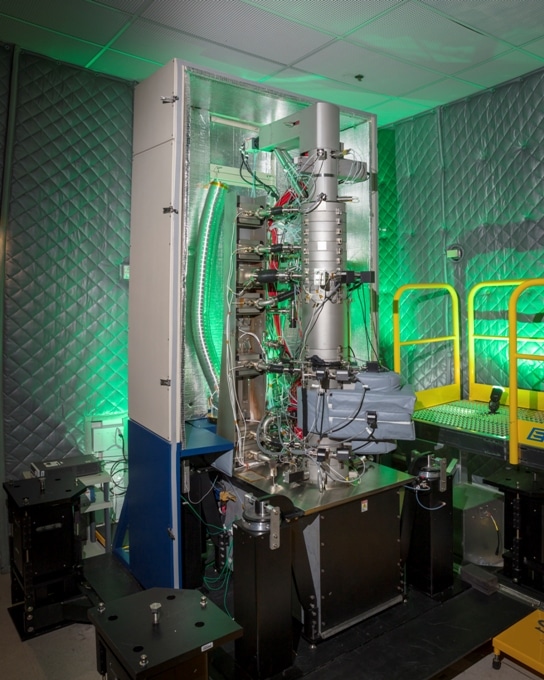Feb 1 2019
A new electron microscopy method capable of detecting the minute variations in the weight of proteins at the nanoscale—while preserving the integrity of the sample—could pave the way for deeper, more wide-ranging studies on the basic building blocks of life.
 Oak Ridge National Laboratory scientists used a monochromated, aberration-corrected scanning transmission electron microscope, or MAC-STEM technique, that detects the subtle changes in the weight of proteins at the nanoscale—while keeping the sample intact—and is the perfect complement to a macroscale mass spectrometry experiment. (Image credit: Carlos Jones/Oak Ridge National Laboratory, U.S. Dept. of Energy)
Oak Ridge National Laboratory scientists used a monochromated, aberration-corrected scanning transmission electron microscope, or MAC-STEM technique, that detects the subtle changes in the weight of proteins at the nanoscale—while keeping the sample intact—and is the perfect complement to a macroscale mass spectrometry experiment. (Image credit: Carlos Jones/Oak Ridge National Laboratory, U.S. Dept. of Energy)
Researchers at the Department of Energy’s Oak Ridge National Laboratory illustrated in the journal Science the first use of an electron microscope to instantly identify isotopes in amino acids at the nanoscale without destroying the samples.
Isotopes are usually used to label proteins and molecules. The electron microscope measures the differences in the molecule’s vibrational signatures, which then helps it to track the isotopes with unparalleled spatial resolution and spectral precision.
The method does not damage the amino acids, enabling real-space observation of dynamic chemistry and providing a foundation for a horde of scientific discoveries from simple to complex biological structures spanning the life sciences.
The way we understand the progression of diseases, human metabolism and other complicated biological phenomena is based on interactions between proteins. We study these interactions by labeling specific proteins with an isotope and then tracking it through a chemical reaction to see where it went and what it did. Now, we can track isotopic labels directly with the electron microscope, meaning we can do it with a spatial resolution comparable to the actual size of the proteins.
Jordan Hachtel, Postdoctoral Fellow and Study Lead Author, ORNL.
Their novel experiment, which was carried out at ORNL’s Center for Nanophase Materials Sciences, used monochromated electron energy-loss spectroscopy (EELS) in a scanning transmission electron microscope (STEM). The method the researchers used is sufficiently sensitive to differentiate between molecules that vary by a single neutron on a single atom. EELS was used to note the subtle vibrations in an amino acid’s molecular structure.
Isotopic labels are typically seen on the macroscopic level using mass spectrometry, a scientific tool that reveals a sample’s atomic weight and isotopic composition. Mass spectrometry has incredible mass resolution, but it typically doesn’t have nanometer spatial resolution. It’s a destructive technique.
Juan Carlos Idrobo, Staff Scientist and Study Corresponding Author, ORNL.
A mass spectrometer employs an electron beam to breakdown a molecule into charged fragments that are then categorized by their mass-to-charge ratio. Studying the sample at the macroscale, researchers can only deduce statistically what chemical bonds were likely to have existed in the sample. The sample gets damaged during the experiment, leaving crucial information uncovered.
The new electron microscopy method, as applied by the ORNL team, provides a subtler approach. By placing the electron beam very close to the sample, but not directly touching it, the electrons can stimulate and sense the vibrations without damaging the sample, enabling observations of biological samples at ambient temperature across longer time frames.
Their result brought about a transformation in electron microscopy since the negatively charged electron beam is usually sensitive only to the protons, and not the neutrons. “However, the frequency of the molecular vibrations is dependent on the atomic weight, and the accurate measurement of these vibrational frequencies opens the first direct channel to measure isotopes in the electron microscope,” said Idrobo.
The ORNL-led study team believes their potentially game-changing technology would not substitute but instead complement mass spectrometry and other conventional optical and neutron-based methods presently used to spot isotopic labels.
Our technique is the perfect complement to a macroscale mass spectrometry experiment. With the pre-knowledge of the mass spectrometry, we can go in and spatially resolve where the isotopic labels are ending up in a real-space sample.
Jordan Hachtel, Postdoctoral Fellow and Study Lead Author, ORNL.
Outside the life sciences, the method could be applied to other soft matter, for example, polymers, and possibly in quantum materials where isotopic substitution can play an important role in regulating superconductivity.
The study titled “Identification of Site-Specific Isotopic Labels by Vibrational Spectroscopy in the Electron Microscope” was co-authored by Jordan A. Hachtel, Jingsong Huang, Ilja Popovs, Santa Jansone-Popova, Jong K. Keum, Jacek Jakowski, and Juan Carlos Idrobo all of ORNL; and Tracy C. Lovejoy, Niklas Dellby, and Ondrej L. Krivanek of Nion Co., the designers and manufacturers of the spectrometer and electron microscope employed in the experiments.
The study was aided by DOE’s Office of Science and used a monochromated, aberration-corrected scanning transmission electron microscope, or MAC-STEM, and other resources at ORNL’s Center for Nanophase Materials Sciences, a DOE User Facility.